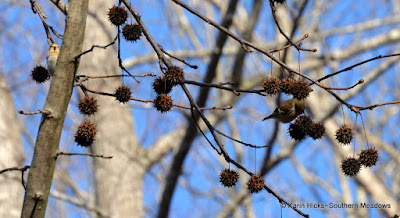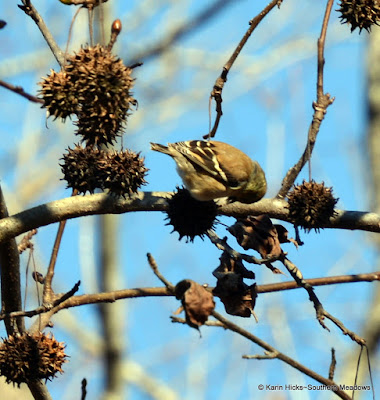Goldfinches and Sweetgum Balls
When the winter landscape stands bare and hides nothing, I find myself doing a lot more looking up into the tree canopy. The denuded trees against a bright blue winter sky are living sculptures providing winter interest to the garden. There is also plenty of activity up there with birds feasting on seeds and tree sap, or fluffing up to stay warm, hawks perched canvasing the land below and squirrels racing around the aerial obstacle course. So, look up, you may be surprised to find a lot more going on in your garden than you thought!
One of the trees, which populates our property is the Sweetgum tree (Liquidambar styraciflua). It is a pioneer species, establishing itself in areas that have been clear cut [farming and development]. It loves our acidic clay soil. While many homeowners don't find this tree so sweet because of the spiky balls that fall and litter the ground, it is a fabulous tree for supporting wildlife. Sweetgum balls, the tree's seed pods, are a goldfinch magnet. Just look up at any mature sweet gum tree in winter and more than likely you'll observe that all the balls dangling from the branches are covered in goldfinches. This is the case in our garden.
They may be difficult to spot initially as they adorn their softer, quieter plumage this time of year (see Sibley Guides to annual plumage cycle of a goldfinch), but look closely and your eye will catch their movement as they hop from one seed pod to another. The prickly balls have lots of compartment on the sphere, each containing two seeds.
Goldfinches often sit on the balls and swing back and forth as they stick their beaks into the seed pod to pull out their prize. They are industrious little birds and pretty entertaining as they swing effortlessly from one ball to another.
Sometimes they perch on a branch, grabbing a ball and pulling it towards them to safely secure it in place and then search for the seeds.
The American sweetgum tree is every inch a treasure, starting in spring when the the star shaped leaves serve as larval host for several moths including the Luna, Promethea, Imperial, and Regal moths. In late fall when the bright green seed pods have dried, birds including purple finches, chickadees, Carolina wrens, towhees, titmice, dove and juncos consume the seeds; as do, squirrels and chipmunks.
The sap, from where it's name derives, is sweet and attracts yellow-bellied sapsuckers who mark the tree trunks with uniform rows of holes. (For more on these woodpeckers read Yellow-bellied sapsuckers and their feeding holes )
Lastly, if you are not a fan of the Sweetgum balls that litter the ground, consider using them as mulch. They work well to deter dogs laying in the flower beds. And, if you're crafty they make a gorgeous wreath with a nice textural element.
One of the trees, which populates our property is the Sweetgum tree (Liquidambar styraciflua). It is a pioneer species, establishing itself in areas that have been clear cut [farming and development]. It loves our acidic clay soil. While many homeowners don't find this tree so sweet because of the spiky balls that fall and litter the ground, it is a fabulous tree for supporting wildlife. Sweetgum balls, the tree's seed pods, are a goldfinch magnet. Just look up at any mature sweet gum tree in winter and more than likely you'll observe that all the balls dangling from the branches are covered in goldfinches. This is the case in our garden.
 |
| Can you find the goldfinches? |
They may be difficult to spot initially as they adorn their softer, quieter plumage this time of year (see Sibley Guides to annual plumage cycle of a goldfinch), but look closely and your eye will catch their movement as they hop from one seed pod to another. The prickly balls have lots of compartment on the sphere, each containing two seeds.
Goldfinches often sit on the balls and swing back and forth as they stick their beaks into the seed pod to pull out their prize. They are industrious little birds and pretty entertaining as they swing effortlessly from one ball to another.
Sometimes they perch on a branch, grabbing a ball and pulling it towards them to safely secure it in place and then search for the seeds.
The American sweetgum tree is every inch a treasure, starting in spring when the the star shaped leaves serve as larval host for several moths including the Luna, Promethea, Imperial, and Regal moths. In late fall when the bright green seed pods have dried, birds including purple finches, chickadees, Carolina wrens, towhees, titmice, dove and juncos consume the seeds; as do, squirrels and chipmunks.
The sap, from where it's name derives, is sweet and attracts yellow-bellied sapsuckers who mark the tree trunks with uniform rows of holes. (For more on these woodpeckers read Yellow-bellied sapsuckers and their feeding holes )
Lastly, if you are not a fan of the Sweetgum balls that litter the ground, consider using them as mulch. They work well to deter dogs laying in the flower beds. And, if you're crafty they make a gorgeous wreath with a nice textural element.



.png)
